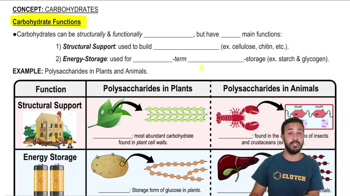Table of contents
- 1. Introduction to Biology2h 42m
- 2. Chemistry3h 40m
- 3. Water1h 26m
- 4. Biomolecules2h 23m
- 5. Cell Components2h 26m
- 6. The Membrane2h 31m
- 7. Energy and Metabolism2h 0m
- 8. Respiration2h 40m
- 9. Photosynthesis2h 49m
- 10. Cell Signaling59m
- 11. Cell Division2h 47m
- 12. Meiosis2h 0m
- 13. Mendelian Genetics4h 44m
- Introduction to Mendel's Experiments7m
- Genotype vs. Phenotype17m
- Punnett Squares13m
- Mendel's Experiments26m
- Mendel's Laws18m
- Monohybrid Crosses19m
- Test Crosses14m
- Dihybrid Crosses20m
- Punnett Square Probability26m
- Incomplete Dominance vs. Codominance20m
- Epistasis7m
- Non-Mendelian Genetics12m
- Pedigrees6m
- Autosomal Inheritance21m
- Sex-Linked Inheritance43m
- X-Inactivation9m
- 14. DNA Synthesis2h 27m
- 15. Gene Expression3h 20m
- 16. Regulation of Expression3h 31m
- Introduction to Regulation of Gene Expression13m
- Prokaryotic Gene Regulation via Operons27m
- The Lac Operon21m
- Glucose's Impact on Lac Operon25m
- The Trp Operon20m
- Review of the Lac Operon & Trp Operon11m
- Introduction to Eukaryotic Gene Regulation9m
- Eukaryotic Chromatin Modifications16m
- Eukaryotic Transcriptional Control22m
- Eukaryotic Post-Transcriptional Regulation28m
- Eukaryotic Post-Translational Regulation13m
- 17. Viruses37m
- 18. Biotechnology2h 58m
- 19. Genomics17m
- 20. Development1h 5m
- 21. Evolution3h 1m
- 22. Evolution of Populations3h 52m
- 23. Speciation1h 37m
- 24. History of Life on Earth2h 6m
- 25. Phylogeny2h 31m
- 26. Prokaryotes4h 59m
- 27. Protists1h 12m
- 28. Plants1h 22m
- 29. Fungi36m
- 30. Overview of Animals34m
- 31. Invertebrates1h 2m
- 32. Vertebrates50m
- 33. Plant Anatomy1h 3m
- 34. Vascular Plant Transport1h 2m
- 35. Soil37m
- 36. Plant Reproduction47m
- 37. Plant Sensation and Response1h 9m
- 38. Animal Form and Function1h 19m
- 39. Digestive System1h 10m
- 40. Circulatory System1h 57m
- 41. Immune System1h 12m
- 42. Osmoregulation and Excretion50m
- 43. Endocrine System1h 4m
- 44. Animal Reproduction1h 2m
- 45. Nervous System1h 55m
- 46. Sensory Systems46m
- 47. Muscle Systems23m
- 48. Ecology3h 11m
- Introduction to Ecology20m
- Biogeography14m
- Earth's Climate Patterns50m
- Introduction to Terrestrial Biomes10m
- Terrestrial Biomes: Near Equator13m
- Terrestrial Biomes: Temperate Regions10m
- Terrestrial Biomes: Northern Regions15m
- Introduction to Aquatic Biomes27m
- Freshwater Aquatic Biomes14m
- Marine Aquatic Biomes13m
- 49. Animal Behavior28m
- 50. Population Ecology3h 41m
- Introduction to Population Ecology28m
- Population Sampling Methods23m
- Life History12m
- Population Demography17m
- Factors Limiting Population Growth14m
- Introduction to Population Growth Models22m
- Linear Population Growth6m
- Exponential Population Growth29m
- Logistic Population Growth32m
- r/K Selection10m
- The Human Population22m
- 51. Community Ecology2h 46m
- Introduction to Community Ecology2m
- Introduction to Community Interactions9m
- Community Interactions: Competition (-/-)38m
- Community Interactions: Exploitation (+/-)23m
- Community Interactions: Mutualism (+/+) & Commensalism (+/0)9m
- Community Structure35m
- Community Dynamics26m
- Geographic Impact on Communities21m
- 52. Ecosystems2h 36m
- 53. Conservation Biology24m
4. Biomolecules
Lipids
Problem 8`
Textbook Question
Which of the following substances is a major component of the cell membrane of a fungus? a. cellulose b. chitin c. cholesterol d. phospholipids
 Verified step by step guidance
Verified step by step guidance1
Understand the structure and function of fungal cell membranes. Fungal cell membranes are similar to other eukaryotic membranes but have unique components specific to fungi.
Review the role of phospholipids in cell membranes. Phospholipids are the primary structural component of all eukaryotic cell membranes, forming a bilayer that provides fluidity and acts as a barrier.
Consider the role of chitin. Chitin is a polysaccharide found in the cell walls of fungi, not the cell membrane. It provides structural support to the fungal cell wall.
Evaluate the role of cellulose. Cellulose is a polysaccharide found in the cell walls of plants, not fungi, and is not a component of fungal cell membranes.
Assess the role of cholesterol. Cholesterol is found in animal cell membranes, where it helps regulate fluidity, but it is not a major component of fungal cell membranes.
 Verified video answer for a similar problem:
Verified video answer for a similar problem:This video solution was recommended by our tutors as helpful for the problem above
Video duration:
1mPlay a video:
Was this helpful?
Key Concepts
Here are the essential concepts you must grasp in order to answer the question correctly.
Cell Membrane Structure
The cell membrane is a biological barrier that surrounds the cell, composed primarily of a phospholipid bilayer. This structure allows for selective permeability, enabling the cell to maintain homeostasis by controlling the movement of substances in and out. In fungi, the composition of the cell membrane differs from that of plants and animals, which is crucial for understanding their unique cellular functions.
Recommended video:
Guided course

Prokaryotic Cell Structures 1
Chitin
Chitin is a long-chain polymer of N-acetylglucosamine, a derivative of glucose, and serves as a key structural component in the cell walls of fungi. Unlike cellulose in plants, chitin provides rigidity and strength, allowing fungi to maintain their shape and protect against environmental stresses. Understanding chitin's role is essential for recognizing how fungi differ from other organisms in terms of cellular structure.
Recommended video:
Guided course

Carbohydrate Functions
Phospholipids
Phospholipids are molecules that form the fundamental building blocks of cell membranes. They consist of a hydrophilic (water-attracting) 'head' and two hydrophobic (water-repelling) 'tails,' which arrange themselves into a bilayer. This arrangement is critical for membrane fluidity and functionality, allowing for the formation of compartments within cells and facilitating communication and transport across the membrane.
Recommended video:
Guided course

Phospholipids
Related Videos
Related Practice













